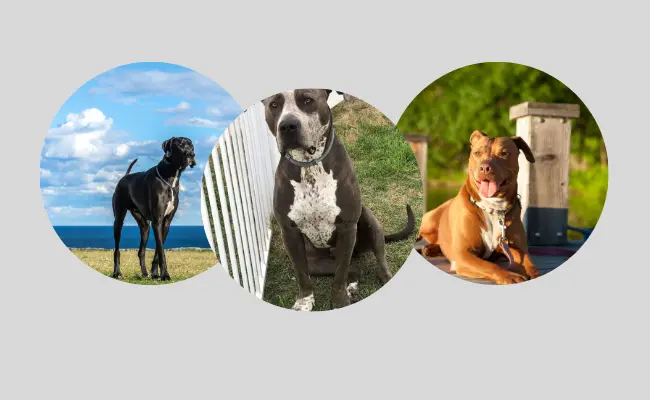
The Great Dane Pitbull mix, also known as the Great Danebull, is a special kind of dog that combines the best qualities of both breeds. This unique blend brings together the energy, good health, and loving nature of the Pit Bull with the friendly, big size, and patient demeanor of the Great Dane. The result is a lovable and lively breed that’s also very friendly and majestic!
These dogs are gentle, loving, and really affectionate, making them a great choice for families. They’re on the larger side, often categorized as a giant-sized dog, and they absolutely adore playing and spending time with their human families. People commonly refer to them as Great Danebulls or Great Dane Pitbulls.
Great Dane Pitbull mixes, or Great Danebulls, are sweet but quite demanding when it comes to attention. So, they’re best suited for families who can dedicate plenty of time and energy to them. If they’re left alone too often, they can experience serious separation anxiety.
Their gentle and loving nature makes them wonderful companions for kids and other dogs. Because they have lots of energy, it’s important to teach them good behavior when they’re young. The good news is they’re smart and eager to please, which makes training relatively easy if you’re consistent and firm.
While many families love these dogs, it’s unfortunate that some of them end up in shelters or rescue organizations. If you’re thinking about getting one, consider adopting a puppy instead of buying from a breeder. This not only can save a dog’s life but also save you some money.
Great Dane Pitbull Mix Overview
| Weight | 60-100 pounds |
| Height | 24-30 inches |
| Lifespan | 10-15 years |
| Temperament | Gentle, affectionate, protective, sweet, friendly, intelligent, playful |
| Suitable for | Families, active individuals, multi-pet homes, large homes, fenced yard |
| Colors | Black, white, blue, fawn, red, brown, sable, and brindle, or a combination of the colors |
Breed History & Parent Breeds
The history of the Great Danebull can be a bit tricky to uncover, like many mixed breed dogs. Instead, let’s dive into the stories behind its parent breeds, starting with the Great Dane.
Great Danes
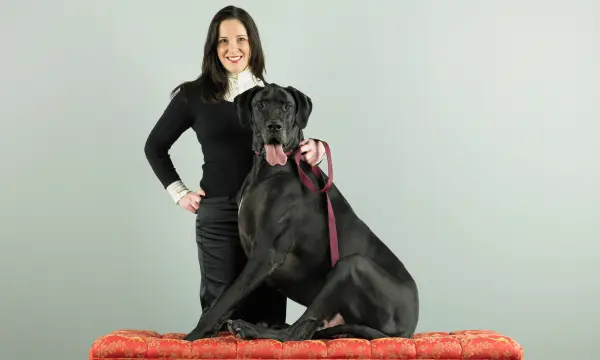
The ancestors of Great Danes can be traced back to ancient times. Drawings resembling these dogs have been found on Egyptian artifacts, suggesting their existence in those early days. It’s believed that Assyrians played a role in spreading these dogs to other parts of the world, including Greece and Italy.
When Great Danes made their way to Germany, they were originally used for hunting wild boars. In those times, they were called “Boar Hounds” due to their hunting prowess. However, as the years passed, their role evolved, and they became dogs favored by German nobility. These noble folks cherished the most handsome Danes and even kept them indoors, leading to a change in their name to “chamber dogs.”
Interestingly, the name “Great Dane” didn’t emerge until a Frenchman visited Denmark in the 1700s and saw this new breed. Despite having no Danish origins, the name stuck. In 1880, German authorities held a vote to rename the breed “Deutsche Dogge,” which means German Dog, but this name didn’t catch on in English-speaking countries.
Throughout the 18th Century, Great Danes continued to hold a prestigious position as guardians of carriages and estates. The shift from boar hunting to companionship led to their development into a gentle and affectionate breed. The American Kennel Club officially recognized Great Danes as a breed in 1887, ranking them as the 34th most recognized breed, and they currently hold the 16th spot in popularity.
Pitbull
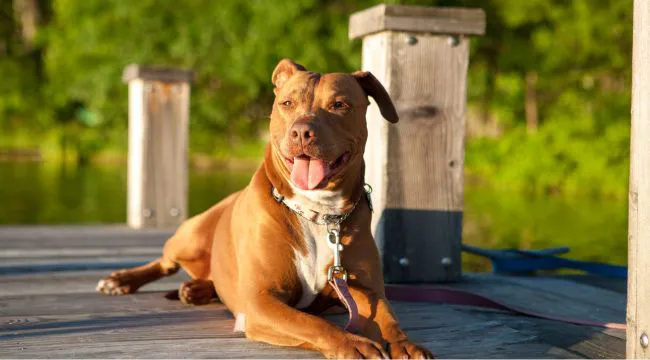
Pitbulls have a rather complex history, with roots tracing back to Old English Bulldogs. These dogs were originally used for a brutal form of entertainment known as “bull baiting,” where they chased bulls for hours until the animals tired out. This cruel practice was outlawed by the British Parliament in 1835, shifting the focus to “ratting,” where dogs tried to catch as many rats as possible. The term “pit” in Pitbull actually refers to the pit where rats were placed to prevent their escape.
As time passed, the public’s interest waned in ratting, leading to the gruesome practice of dogfighting. This marked the start of a dark and painful chapter in the breed’s history. Despite their involvement in such cruel activities, Pitbulls were bred to be gentle towards humans, and this affectionate nature is a hallmark of the breed today.
Pitbulls made their way to the United States shortly before the Civil War, brought by immigrants from the British Isles. Life in America was kinder to these dogs, and they found new roles, including herding cattle and sheep, guarding livestock and families, and assisting in hunts. Their loyalty and affection towards their owners quickly transformed them into cherished family companions.
During World War I and II, Pitbulls became famous in the United States, featuring in numerous advertisements as the national mascot. They were even the first dogs employed by the United States during wartime. Despite their popularity and rich history in the country, the American Kennel Club does not officially recognize them as a breed. However, the United Kennel Club and the American Dog Breeders Association do acknowledge and recognize the Pitbull breed.
Great Dane Pitbull Mix
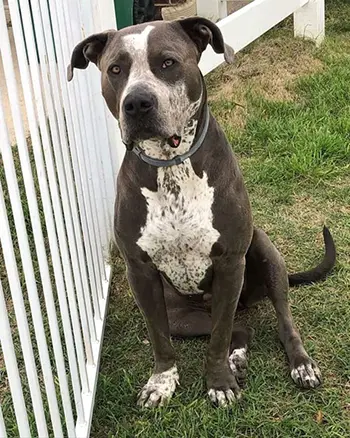
The Great Danebull is a special dog mix, blending the Great Dane and the Pitbull. They bring together the big size and strong muscles of the Great Dane with the cute and playful looks of the Pit Bull, especially those floppy ears that make them so charming! But, just like with other mixed breeds, how they look can be a bit different from one dog to another.
Size & Appearance
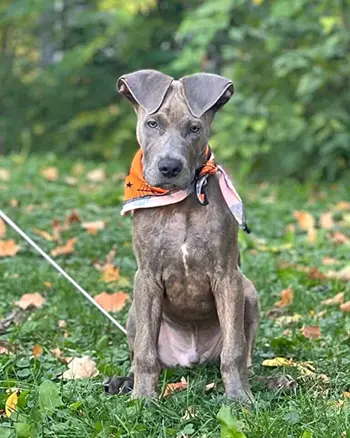
The Great Dane Pitbull Mix is a big dog, ranging from large to giant in size. They can weigh between 60 to 100 pounds and stand tall at 24 to 30 inches. Their body is long and slender, resembling more of a Great Dane’s physique than the muscular build of a Pitbull. You’ll notice they have long legs and large paws.
Their ears are typically short, square-shaped, and hang loosely, resembling a bit more of a Pitbull’s ear style than a Great Dane’s. When it comes to coat color, it can vary, often depending on the coloring of their parents. They might be white, black, fawn, blue, brown, red, brindle, sable, or even a mix of these shades. Their long tail usually has a slight upward curve.
The Great Dane Pitbull mix boasts a short, shiny, smooth, and firm coat. It’s somewhat dense, but it’s a good idea to provide extra care during colder months, such as giving your dog a coat to keep warm. They can handle warmer weather better but aren’t too fond of extreme heat.
Great Dane Pitbull Mix Temperament
It’s no surprise that this unusual blend of breeds results in an affectionate dog, as both Great Danes and Pitbulls are known for being people-pleasers. They are playful, loyal, and loving, making them excellent companions for families.
These dogs get along well with children, but it’s essential to teach your child how to behave around your new dog. Like most dogs, they may react negatively to things like hair pulling or hitting. Due to their large size and playful nature, it’s a good idea to supervise your children while they play with the dog to prevent accidental knocking over.
They are happiest when cuddling with their family and often think they’re lap dogs, despite their substantial size. They enjoy running and playing outdoors with their owners to burn off their energy. Due to their outgoing nature, if these dogs are socialized from a young age, they tend to be great around other people and animals.
These dogs are real attention-seekers and crave companionship from their owners when they’re at home. Their strong desire for company means they can suffer from severe separation anxiety, which can lead to stress and undesirable behaviors like excessive barking, chewing, or digging.
Highly intelligent and eager to please, this breed is generally easy to train if done correctly. They quickly pick up commands, and because of their affectionate nature, they respond best to positive reinforcement. Keep in mind that since they are a hybrid dog, their temperament can vary from one puppy to another. To get a sense of a puppy’s personality, it’s often a good idea to look at the parents and other offspring.
Advantages of the Great Dane and Pitbull Mix
It’s easy to see why people find the mix of a Pit Bull and a Great Dane so appealing. Let’s dive into the reasons why this crossbreed is a great choice!
- The Best of Both Worlds: This blend brings together the friendly and large nature of the Great Dane with the loyalty and protective instincts of the Pit Bull. You get a dog that enhances the positive qualities of its parents while toning down some of the less desirable traits. There’s nothing better than a pet that’s both devoted to you and welcoming to strangers, or one that’s reasonably low-maintenance yet still big and strong.
- Health: Great Danebulls often enjoy better health compared to regular Great Danes.
- Watchdog Instincts: They combine the alertness of Pit Bulls with the natural guarding instincts of Great Danes, making them highly aware of their surroundings and unafraid to sound the alarm.
- Friendliness with Other Dogs: Despite their lineage, which includes Pit Bulls from dogfighting backgrounds, don’t worry! Great Danebulls retain the amiable nature of Great Danes while having some of the energetic traits of Pit Bulls.
- Affectionate: Despite their larger size, Great Danebulls hold onto the loving tendencies of their Pitbull ancestors. In other words, they see themselves as smaller dogs and are not shy about getting up close and personal. Many people cherish dogs for their cuddliness, and Great Danebulls are surprisingly good at providing such unconditional affection!
- Low Grooming Demands: Much like their Pitbull relatives, Great Danebulls are not high-maintenance. They don’t have a thick fur coat to contend with. While they do shed periodically, it’s not as excessive as some other breeds or hybrids.
- Easy to Train: Thanks to their intelligence and friendly, loyal nature, they’re a dog breed that’s relatively easy to train.
Disadvantages of the Great Dane and Pitbull Mix
- General Hybrid Considerations: While some folks might see these “best of both worlds” breeds as a perfect choice, others may prefer the pure aggressiveness of a Pitbull or the majestic look of a pure Great Dane. It’s essential to thoroughly research both breeds before deciding if a mix suits your needs.
- Exercise Needs: These dogs are super active and need plenty of exercise every day. If you can’t provide them with this, they might become restless or face health issues.
- Shorter Lifespan: Despite being relatively healthy, being a large breed comes with certain limitations. Similar to Great Danes, it’s somewhat rare for them to live beyond 12 years, even if they’re as healthy as their Pit Bull parent.
- Separation Anxiety: These dogs can become extremely attached to their owner. If you have to leave them alone for extended periods, they may become vocal or engage in destructive behavior around the house.
- Size Concerns: The Great Dane and Pitbull Mix can be quite massive, often exceeding 90 pounds. However, they tend to see themselves as smaller than they are. While this can be endearing and promote affection, it might pose a problem if they jump on frail individuals or small children. So, it’s essential to be cautious!
Exercise Needs & Living Requirements
When thinking about bringing a Great Dane Pitbull into your home, it’s crucial to keep in mind that they require plenty of space and exercise time. This big breed is full of energy and needs ample room to stretch their legs. They are most suitable for families with a spacious backyard for them to play in and may not be the best fit for apartment living. However, if you do live in an apartment, these dogs can adapt if they receive a substantial amount of exercise throughout the day to burn off their energy.
On an average day, these dogs typically need about one to one and a half hours of exercise. You can achieve this through walks, runs, or simply playing in your yard. They’re very playful and enjoy activities like fetch, tug-of-war, or tackling obstacle courses. When selecting toys for them, keep in mind that these dogs are large, with strong jaws, so opt for toys that can withstand some vigorous play and tugging.
Training a Pitbull Great Dane Mix
Great Dane Pitbull mixes are intelligent and eager to please, which makes them relatively easy to train. Their smarts enable them to grasp commands from their owners quite well. However, it’s crucial to maintain firmness and consistency during training to gain the dog’s respect and trust. If you’re inconsistent with your commands, it can confuse the dog and lead to them not paying attention.
Because this breed is attached to their owners, they respond best to positive reinforcement during training. So, it’s important to keep training sessions positive and rewarding. Just like with most breeds, it’s generally easier to train puppies than adults, but both can be accomplished.
Puppies of this mix should start training and socialization at a young age to develop good manners. Since they have lots of energy, it’s vital to train them when it’s the right time to use that energy constructively. With repetition and consistency, a puppy can pick up good habits relatively quickly.
If you adopt an untrained adult mix, it’s not impossible to train them, but it may be a bit more challenging. These dogs will already have established habits, so patience becomes a key factor. With a lot of effort, patience, and skill, you can start to see improvements in your dog’s behavior over time.
Health of a Pitbull Great Dane Mix
In general, this breed is quite healthy, but there are some health issues that can be passed down from their parent breeds. To reduce the risk of adopting a dog with these health concerns, it’s a good idea to obtain the medical records of the parents.
- Hip Dysplasia: This is a genetic condition that affects the hip joint, causing varying degrees of discomfort. It occurs when the hip joint doesn’t align properly, resulting in pain and costly treatment.
- Cardiomyopathy: This condition is more common in the Great Dane side of the family. It’s a heart disease that causes irregular heartbeats. While it can be sudden and severe, it’s manageable with medication, allowing the dog to lead a full life.
- Bloat: Also known as gastric dilatation volvulus, this condition can be life-threatening. It involves a sudden buildup of gas in the stomach and twisting of the blood vessels supplying the stomach. Swift treatment is essential to avoid irreversible damage and the release of harmful toxins.
- Cancer: This breed, particularly on the Great Dane side, is prone to various types of cancer, including bone cancer. Early detection is crucial, as treatment may involve costly chemotherapy or even limb amputation. Regular vet check-ups, proper care, and a good diet can contribute to a long, healthy life.
Nutrition
This large dog has a hearty appetite and typically requires between 3 to 6 cups of food per day. This could cost the owner around $55 or more each month, depending on the brand of dog food.
They thrive on high-quality dry dog food designed for large breed dogs. Ensure they always have access to fresh water and consider providing daily fish oil or glucosamine supplements for joint health.
Recommended Dog Food: Choose a food that’s rich in protein and of high quality, free from artificial ingredients or fillers. Here are some options to consider:
- The Farmer’s Dog fresh, human-grade recipes
- American Journey Salmon & Sweet Potato Recipe Grain-Free Dry
- Taste of the Wild High Prairie Grain-Free Dry
Since this breed may be prone to bloat, which can result from eating too quickly, consider using a slow feeder. This not only helps prevent bloat but also provides mental stimulation for your pup. It’s a two-in-one solution!
Grooming
Taking care of your Great Dane Pitbull mix is relatively straightforward, but be prepared for regular shedding, which means you’ll need to keep up with cleaning your home and furniture. While they require daily brushing, their short hair makes it easy. Try not to bathe them too frequently as it can strip their skin of natural oils; instead, only give them a bath when they’re noticeably dirty.
Check and clean their ears at least once a week, and trim their nails when needed. If you’re uncomfortable doing this yourself, a professional groomer can help. Don’t forget their dental health; brush their teeth at least every three days.
Here are the tools you’ll need:
Breeders & Puppy Costs
Several breeders specialize in hybrid breeds like this one. When buying from a breeder, make sure they have a good reputation and provide information about the health and temperament of the parents. Typically, you can expect to spend around $600 to $1,000 on a puppy from a breeder.
Rescues & Shelters
Rescues and shelters are excellent places to find Great Dane Pitbull mixes. Not only can you potentially save a dog’s life by adopting from them, but it can also be more cost-effective. Look for these organizations online, such as:
- Rescue Me: A wide-reaching organization that can help you find a mix near you.
- Pitbull Rescue Central: Specializes in Pitbulls and their mixes.
Adoption costs vary but are generally lower than buying from a breeder.
As Family Pets
Great Dane Pitbulls make wonderful family pets. They are affectionate, easy-going, and great with families. However, they can be quite clingy and require a lot of attention from their owners. Despite their large size, they often act like lap dogs and are prone to separation anxiety if left alone for long periods. They’re playful, energetic, and intelligent, benefiting from early training to learn proper behavior.
Final Thoughts
If you’re looking for a breed that combines the health, energy, and low maintenance of a Pit Bull with the friendliness, size, and awareness of a Great Dane, this mix is a great choice! Keep in mind that results can vary, so do your research beforehand and shower your new dog with love!
This playful breed is an excellent family dog that gets along with children and other animals. Due to their size, parents should supervise young children when playing with the dog. With their boundless energy, they need plenty of exercise, whether it’s going for a run or playing fetch. They thrive in families with spacious yards for them to run around in.
FAQ:
How big will a Great Dane Pitbull mix get?
This mixed breed typically resembles either a Pit Bull or a Great Dane. They stand at a height of approximately 24 to 30 inches and should weigh between 60 to 100 pounds.
What is a Great Dane Pitbull mix called?
The Great Dane and Pitbull Mix, also called the Great Danebull, is a breed that combines the best qualities of both parent breeds.
What does a Pitbull and a Great Dane mix look like?
A Pitbull and Great Dane mix, often referred to as a Great Danebull, typically exhibits a combination of physical traits from both parent breeds. These dogs are generally large to giant-sized, standing between 24 to 30 inches tall and weighing approximately 60 to 100 pounds. Their appearance can vary, but they often have a lean and muscular body, more akin to a Great Dane. Their ears are usually short, square-shaped, and may hang loosely, resembling the Pitbull’s ears. Coat color can vary and depends on the coloring of their parents, with possibilities including white, black, fawn, blue, brown, red, brindle, sable, or a combination of these colors. Their coat is short, glossy, and relatively easy to maintain. Additionally, they may have a slightly curled tail. Overall, a Great Dane and Pitbull mix can have a unique and striking appearance that blends characteristics from both parent breeds.
Are Pitbull mixes good dogs?
Pit Bulls are recognized for their loving and friendly nature, as well as their affection for their owners. When they receive proper socialization and training, they can be wonderful family pets. Despite occasional strong-willed behavior, Pit Bulls are highly intelligent and eager to please, making training relatively easy.
How long do Danebulls live?
Great Danebulls enjoy being moderately active and thrive on receiving lots of attention. These dogs can have a lifespan of up to 14 years and typically weigh between 60 and 90 pounds. When they reach full maturity, they usually stand between 24 and 28 inches tall.



